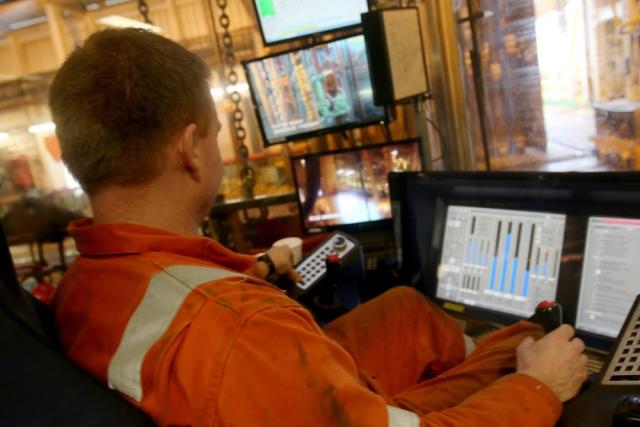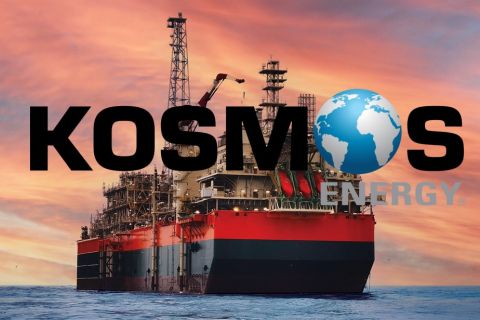
A driller works at the Johan Sverdrup Field in the North Sea. (Source: Kjetil Eide/Equinor)
HOUSTON—When the Johan Sverdrup Field in the North Sea comes onstream later this year, it will not only begin its journey toward producing as much as 660,000 barrels per day at peak. The field will also serve as an example of how Equinor and partners are turning digital talk into reality.
The field will have a digital twin, providing access to 3-D model and real-time information, including via iPads or mobile phones, Anders Opedal, executive vice president of technology, projects and drilling for Equinor, told attendees of Halliburton’s Landmark Innovation Forum and Expo (LIFE) on Aug. 27. Such technology, he said, enables offshore workers to increase efficiency and safety with real-time collaboration through live checklists and work orders.
“We are also installing fiber cables into wells and on the seabed at the combined lengths of 670 kilometers or 450 miles. Data from the fiber cables provide information about the reservoir in real time, increasing our understanding of reservoir behavior, improve integrity monitoring and production from wells,” Opedal said. “The fiber cables in the wells alone would produce more data in three months than we have in total in Equinor today. The continuous stream of data from the wells will be the equivalent of streaming 18,000 Netflix movies at the same time.”
Equinor, like many of its peers, is embracing digital technology, incorporating it into the business model and daily operations, as it looks to unlock more resources, lower costs and improve safety among other goals. Many have already partnered with the world’s tech giants—such as Microsoft, Google and Amazon—while working with oilfield service companies such as Halliburton to collaborate to find solutions and improve operations.
RELATED: Halliburton Unveils DecisionSpace 365 Cloud Application Suite
The Norweigan company once stored its data in more than 3,000 different systems, Opedal said, before it put all data into one place—a Cloud-based data platform called Omnia developed in collaboration with Microsoft.
Data can be loaded into the digital platform in seconds, “enabling the subsurface professional to better plan, test and extract knowledge from previous experience,” he said, referring to the Johan Sverdrup Field set to start production in November.
The energy company is also counting on its digital solutions to maximize the potential of the field, which has an expected lifespan of more than five decades with resources estimated at 2.7 billion barrels of oil equivalent.
Equinor has set the bar high, aiming for a 70% recovery rate at the field, compared to the industry average of about 35% and 46% for other fields on the Norwegian Continental Shelf.
In 2018, the company said it tapped Alcatel Submarine Networks for permanent reservoir monitoring (PRM) on the field, calling the seismic technology a “potential digital enabler” for Johan Sverdrup. As explained by Equinor, the PRM technology features seismic sensors embedded into the seabed, resulting in better seismic images of reservoir changes.
The company is also digitally transforming in the drilling and completions area, using high bandwidth connectivity access for its assets and real-time data sensors that enable onshore support of offshore installations, he said.
“[In] the next two years we plan to have 13 to 15 offshore rigs equipped with automated drilling control in our portfolio,” Opedal said. “We believe that automated drilling has the potential to reduce the cost by 15% compared to conventional drilling and the technology platform allow us to automate much, much more.”
Data are at the core of the digital revolution sweeping through the energy industry.
Though there are still concerns about sharing data, given the competitive nature of the business, some companies—including Equinor—have come together to reduce silos typically seen in oil and gas companies and put subsurface and wells data into a single data platform. It’s called the Open Subsurface Data Universe (OSDU).
“One thing is certain data will be key to innovation in the coming years both within Equinor but also to enable more innovation within the industry,” Opedal said. “The challenge is not what data to share but to define the rules of the games for how to share. When this is in place, companies will share data for business purposes.”
In addition to being part of OSDU, Equinor and partners made available in 2018 all subsurface and production data from the Volve Field, which ended production in 2016, in the North Sea. The dataset includes about 40,000 files, the company said on its website.
“Thousands of data files with seismic and production data have now been used by many organizations to train algorithms on reading datasets,” Opedal told LIFE attendees. “We want to further develop this way of core innovation by also sharing data from CO2 storage and handling at the Sleipner Field from the last 40 years. … By making this data available we seek to further enhance innovation within carbon storage, which is we think an important instrument to decarbonize our industry.”
The company said in June it aims to have the digital platform for sharing CO2 storage data online in September.
Equinor, which changed its name from Statoil in May 2018, is an explorer and producer of not only oil and gas but also wind and solar.
Recommended Reading
E&P Earnings Season Proves Up Stronger Efficiencies, Profits
2024-04-04 - The 2024 outlook for E&Ps largely surprises to the upside with conservative budgets and steady volumes.
Some Payne, But Mostly Gain for H&P in Q4 2023
2024-01-31 - Helmerich & Payne’s revenue grew internationally and in North America but declined in the Gulf of Mexico compared to the previous quarter.
Uinta Basin: 50% More Oil for Twice the Proppant
2024-03-06 - The higher-intensity completions are costing an average of 35% fewer dollars spent per barrel of oil equivalent of output, Crescent Energy told investors and analysts on March 5.
In Shooting for the Stars, Kosmos’ Production Soars
2024-02-28 - Kosmos Energy’s fourth quarter continued the operational success seen in its third quarter earnings 2023 report.
M4E Lithium Closes Funding for Brazilian Lithium Exploration
2024-03-15 - M4E’s financing package includes an equity investment, a royalty purchase and an option for a strategic offtake agreement.






